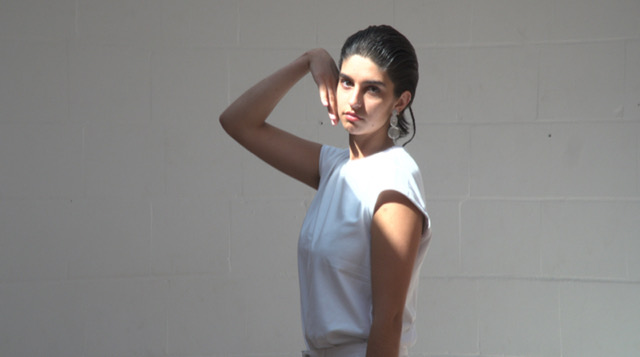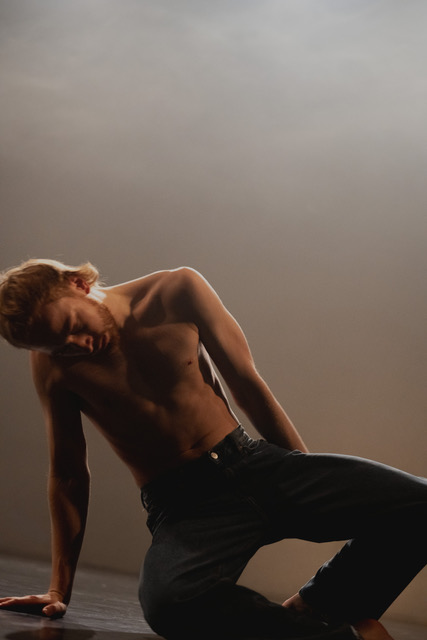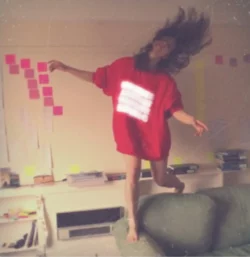On the Archive – A Doorway to Pleasure, Complexity and Other Possible Worlds
Sasha Amaya
The dancer and choreographer Sasha Amaya reflects on her personal and artistic approach to the themes of canon and archive and writes about her work in which she explores European art history in a contemporary context. She highlights baroque dance as a tradition of Western dance and investigates the possibilities of reappropriating it, reports on attempts to dismantle Monteverdi’s opera and researches the construction of male ideal sof beauty in Western Europe. Working with the deconstruction and reconstruction of canonical images, she encounters the archive as a complex place that can be a source of joy as well as of resistance and radical reinterpretation.
Sarabande: Falling for the Archive
Three years ago we premiered Sarabande, a work de- and reconstructing, reimagining, and recreating four Baroque dances. The inspiration for the work had begun the year prior. I was living and working in the medieval abbey of Royaumont, north of Paris, as part of a group of choreographers and composers. In the mornings we took dance class, and in the afternoons we were taught by guest instructors and collaboratively workshopped exercises together. One of our teachers was Béatrice Massin, a choreographer and specialist in Baroque dance, and one of several French choreographers who create neo-Baroque dances for the contemporary stage. Her work with us focused on bringing together our abilities to sing and dance simultaneously to 16th-and 17th-century Baroque song-dance, as well as teaching us how to read Baroque dance scores — a beautiful bird’s eye view format in which the marks on the page indicate the type of footstep, while their placement indicates the overall movement through the space. I was fascinated by this work. The scores were really a new language to learn, something that had to be studied, and which was halting and enriching in the way that painful and halting things are when accomplished. Bringing our limbs and voices together — not in the organic meows of so much contemporary dance practice (something I also very much love) but in the particular and just unfamiliar melodies of the early Baroque and the tongue-in-cheek rhymes of old French — was a genuinely difficult but extraordinarily pleasurable task.
I went deep into this work and relished it. But my Franco-European colleagues were dismissive of the exercises and baffled by my interest: why on earth did I find this interesting? It was SO irrelevant! And, furthermore, had I not already learnt this at school?
Had I not already learnt this at school???
As it turned out, as a dancer trained outside of the Franco-European context, I had definitely not learnt Baroque dance ‘in school’. I was amused and offended by the assumption that I should have. Was it because I grew up in a former colony? Or because the world as a whole should know not only this dance’s descendant, ballet, but also its parent forms? Were we still expected to know the European archive of dance — in addition to language, history, and culture — so well as to shock our colleagues when its niches and antecedents appeared to us as new knowledge?
I was perturbed by this response. It infuriated me that my European-influenced education — obscuring both my own history and the history of the peoples on whose land I grew up — was still somehow seen as not enough. And yet I loved what we were doing — the bird-like forms our bodies created, the sensuality of bridging voice and limb, and the challenge of the cryptic scores. It felt impossible, and a dishonour to myself, to rip the training that had made the acquisition of this type of new knowledge possible out of my body. I had spent years studying ballet, receiving instruction in classical music, learning French and English at school, and taking (mandatory) exams in European history. And while my need for other knowledge was not always fulfilled, that did not make this knowledge unappreciated. These things were also now a part of me. They were me. They hadn’t replaced my origins, but they had added new elements to it.
Thus began the development of my dialogue with the archive of Baroque dance. I collected knowledge from my time with Massin, from the scores that I could now (sometimes) read, and from videos on the internet. In Sarabande I took these dances, with my respect and love for them, and added more of my own bits: my body, my references, my histories, my trainings, to create something new with them — to create a parallel history, and to bring them with love into a new imaginary where their shapes and orientations could be transformed with and through me. At the presentation of Sarabande at the Sophiensaele in Berlin, a primarily German audience watched a foreigner striving to fit herself into their historical forms, not with derision or total pain, but with desire, respect, and pleasure; they accompanied me through the friction of ambiguity that attends something that is both well-loved and problematic.
Orfeo: Generative Adventures in Myth and Music
I found this friction again in the realm of classical music, a space in which contradictions presented themselves on multiple fronts. The so-called canon (viz. archival selection) of classical music has been hegemonic not only in schools of music across Europe, but also throughout North and South America, East Asia, and other parts of the globe. While there now is an undoing and a questioning of how resources in classical music are requisitioned in relation to other arts (a question of resources), and of how classical forms could be displayed (an aesthetic, thematic question), as well as what ought to be in a ‘canon’ or if there should be one at all, there is still support for its preservation and presentation. Facing this tradition is also the place of minorities. As a choreographer and director who is not only a woman, but is also perceived in Germany as ‘other’, I am particularly attuned to the still present assumptions and assertions about who can and cannot — who should and who should not — access and interpret the classical canon. Furthermore, while I studied classical music and the liberal arts growing up — formative pathways for directors — my practice as a dancer and choreographer involves a deeply embodied knowledge which I bring to my interpretive work, which is rare in the world of classical sound. As a racialised woman with an embodied practice, the value of this perspective is undervalued as, ironically, my parallel training in Western classical music, philosophy, and theory is often ignored or underplayed. As such, my takes on the canon are subject to doubt.
In an effort to move through such thorny territory, it was of interest to me to dive most deeply into the archive. As such, I took as a basis for the research the earliest still regularly performed score of opera, Monteverdi’s Orfeo from 1607. In this way, using such an early source in the archive provides us with two opportunities. The first is a chance to challenge notions of lineage and sacrality by engaging touchstones in the archive. As we did in Sarabande, where we examined the Baroque roots of proto-ballet, ballet, and European contemporary dance, doing so allows us to hone in on the ‘source’ of a musical tradition or a subsequent lineage of work — in this case ‘the classical.’ Indeed the focus on a work that is considered the ‘earliest’ or to have ‘origin’ status for a tradition — albeit rarely the first but rather the only one remaining, having been saved from fire and other threats — is essential to a radical examination of the archive and what refractions it can still offer us today.
On a second level, a genuinely engaged treatment of the archive is generative because the real peculiarities of a work — its aesthetic dimensions, intentions, irregularities, conflicts, and contexts — more often than not reveal the complicated situatedness of a piece that offers a plethora of possibilities for interpretation and creation. In this way, we understand clearly, and in concrete detail, that the canonical chronology is just one possible path, and that there could have been other worlds born of the same matter. A deep engagement with the archive thus opens up possibilities, both by illuminating and recasting the ‘source’ of dominant traditions and by honouring the concrete idiosyncrasies of real works of art that could lead us to other possible worlds.
Solo for Boy: Mirroring Beauty and Permission
In Solo for Boy the archive again plays an important role as muse and interlocutor. The work focuses on images of western male beauty, as rooted in the history of portraiture — more precisely, as developed in pastorally located 19th-century portraits of men. During a time of industrialisation, migration from country to city, the growth of a middle class, and the rise of Romanticism, a new figure emerges in painted works: a boyish man in a bucolic setting, whose body — hair slightly ruffled, limbs unfurled carelessly but elegantly — is the site of nonchalant confidence. While the spectrum of beauty has broadened over the last years, this figure still remains a dominant ideal, and one that also appears frequently on the stage of contemporary dance.
What does this type of body elicit? What is it allowed? Versions of this image, from pastoral middle-class men to those of Timothée Chalamet and Eddie Redmayne, are startlingly similar; and it is the archive that allows us a glimpse into the history of how we build bodies, and how we create allowances, habits, and judgements around them.
The archive as such remains a rich and resonant place. Sarabande allowed me to discover that the archive can be a source of joy and pleasure, and that making a unique relationship with the archive is both artistically and politically complex and fruitful. Orfeo taught me that canonical works can be a radical source of reimagination and resistance in the face of oppressive narratives. And Solo for Boy reminded me of how the archive can illuminate the ways in which we are accustomed to perceiving, representing, and valuing ourselves and others through an historical lens as we reflect upon our desires, and on the sticky space between their societal and personal manufacture.



